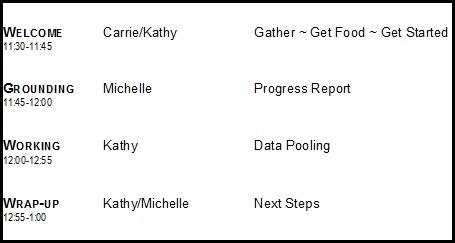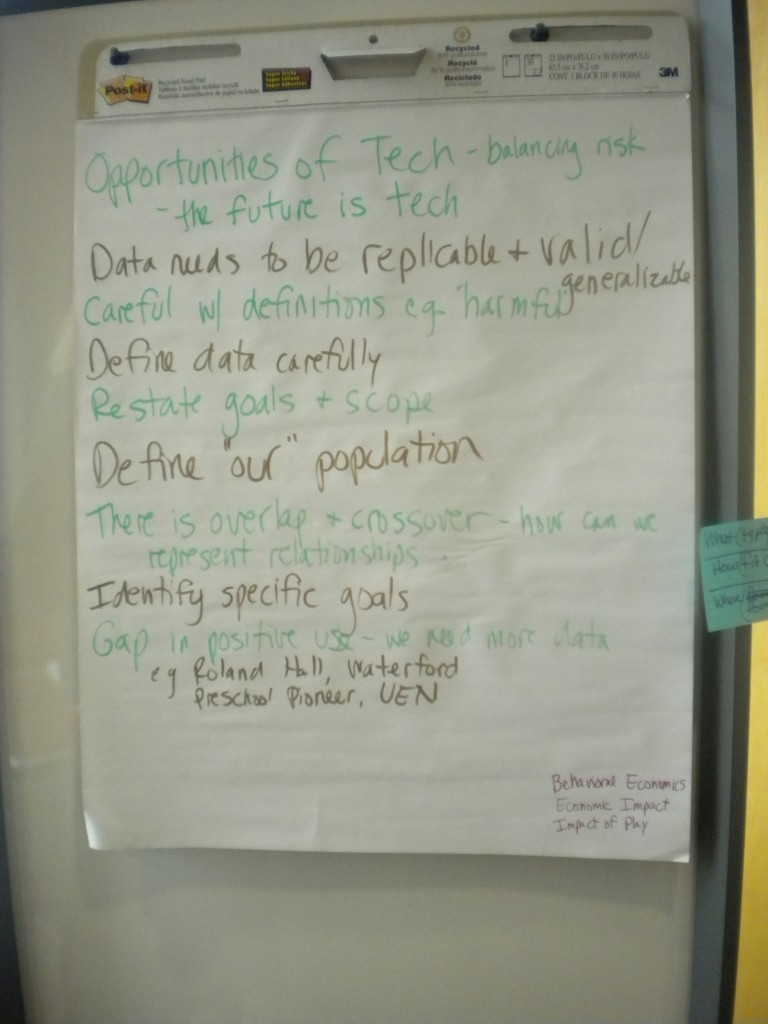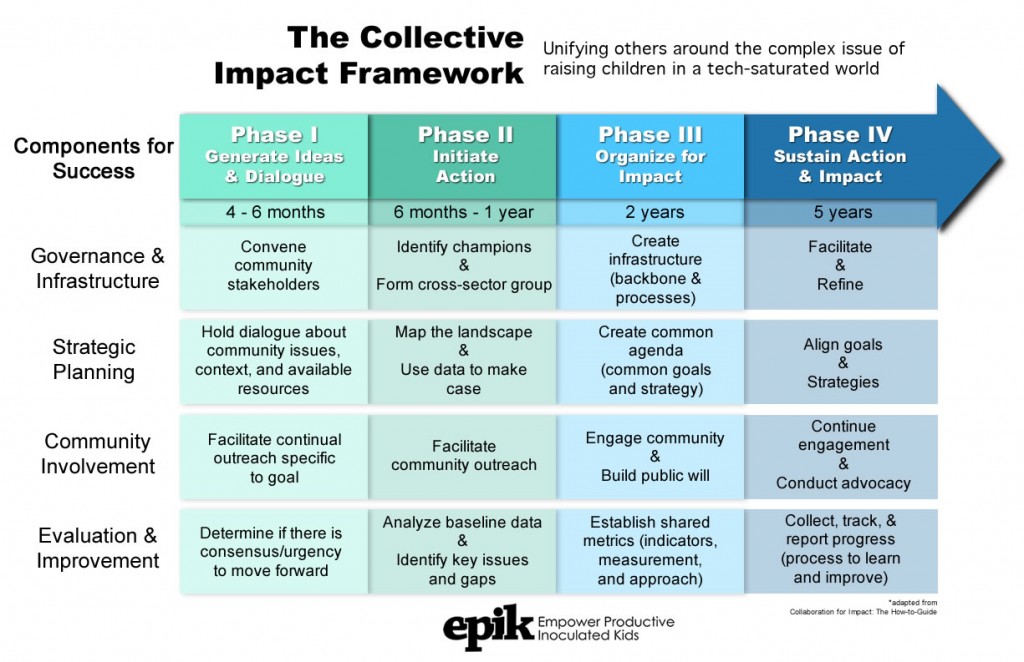Pooling Data Resources (28 Jan 2015 Meeting Report)
January 28, 2015
(Note: This post has been updated from the original to include updated “next steps” information that was emailed to collaborators and interested community members after the report was created. We’ve also included the agenda image and headings which were missing in the original.)
The latest EPIK Alliance community collaboration meeting was held at the West Jordan library on January 28, 2015 from 11:30-1:00. Many thanks to Carrie Rogers-Whitehead for hosting the meeting. Following is the agenda from the meeting:

Grounding:
The year 2015 will be an exciting year for the EPIK Alliance initiative. The first phase of our collaborative community work has been focused on bringing cross-sector stakeholders together to hold dialogue about the complex issue of raising children in a tech-saturated world. For collective impact to be successful, dialogue must transition to more focused work around data. January’s meeting was designed to start bringing data into the discussions and begin to create a shared pool of potential data resources/sources that could be used by the collective as we move into Phases 2 and 3.
Phase 2 will involve more specific work using data to start to scope the issue, map the landscape, make a case for the Alliance’s work, and engage in community outreach. Data will also be the foundation of Phase 3, where the Alliance will create a collective strategy, a common agenda, shared goals, and shared measures and continue to expand community involvement and investment.
Working:
At the meeting on January 28, Alliance members were invited to answer the following question:
What data resources/sources do you use, know about, and/or have access to that could help the Alliance gather data to more clearly define and assess the various facets of the complex issue of raising children in a tech-saturated world?
More specifically, in the meeting, participants answered the following questions:
- What topic(s) is/are the data resource(s) addressing? (e.g., technology use in children, media literacy, education, behavioral health concerns)
- What type of data (e.g., qualitative, quantitative, etc)
- What kind of data resource is it and/or who is gathering the information? (e.g., database, research report, observation & experience)
Participants in the meeting organized their contributions based on what facet of the complex issue the data resource addresses.
Some snapshots of the work done in the meeting are below.
The following eight categories (“issue buckets”) were created by a small work group last fall. The work group was assigned the task of processing outputs from the Issue Mapping and Issue Clustering meetings. (Working descriptions of the categories as created by a small work group in the Alliance are in parentheses.) The categories used in the January meeting varied slightly, but it was decided to use the work group’s categories to create the final meeting output document for the Data Pooling meeting.
- General Technology Environment and Accessibility (The access to and usability of technology has created open channels with no limits.)
- Emotional and Mental (Behavioral) Health (Technology can strengthen or threaten a child’s emotional and mental [behavioral] health.)
- Social Relationships and Connection (Technology can be the connector or barrier to healthy relationships.)
- Education, Learning, Creativity & Media Literacy (Technology creates an ever expanding opportunity for education, knowledge, creativity and self determination.)
- Physical Health and Safety (Use of technology can promote or impair a child’s physical health and safety.)
- Productivity (Use of technology greatly impacts a child’s productive or nonproductive use of time.)
- Ability to Influence (The ability [of children] to influence others through technology leads to greater power — and also vulnerability.)
- Parenting (Parenting is a significant factor in a child’s choices with technology.)
We’ve also compiled contributions from Alliance members who sent in information via email before the meeting, both as input for the meeting and to help an Alliance member with a bill he was working on (hence the heavy focus on media literacy).
Insights and Impressions
As is always the case, our time was limited for the Insights and Impressions discussion at the end of the working portion of the meeting, but important thoughts came out of the discussion. In fact, the discussion is a great segue into the work that will be happening in the next few months as the Alliance will be preparing to move into Phase 2.
- The future is tech. Opportunities need to be considered, balancing risk
- There is a gap in data with regard to positive use of tech–we need more data
- e.g. Roland Hall, Waterford & Preschool Pioneer, UEN
- When we work with data, it needs to be replicable & valid/generalizable
- We need to use caution because data can be skewed based on whom you sample
- We need to define data carefully
- We need to be careful with definitions e.g. “harmful.” Definitions need to be set. [This is one reason why using data as a foundation will be important.]
- Can we get a baseline for what is “harmful” with regard to technology?
- Research can contradict itself. e.g., some research would claim porn is not harmful/can be beneficial [this kind of contradiction may also guide the group to create some value statements or assumptions, which will be part of the process as things continue to unfold]
- Restate/Identify goals and scope
- Define “our” population
- There is overlap & crossover between issue categories/buckets
- How can we represent relationships between them?

Next Steps:
In the meeting, potential meeting dates were presented to attendees for March and April. In post-meeting analysis, the following things were considered in refining next-step plans.
- Input from Alliance members through patterns in meeting Insights and Impressions
- One-on-one conversations with Alliance and community members
- The progress in the past six months around “holding dialogue around the issue”
- Careful assessment of the Alliance’s work in the context of the collective impact process
- Meeting design/planning work
- Discussions among the EPIK board, director and consultant/facilitator
It was determined that the Alliance is ready for Phase 2.1, where a consistent group of “champions” will be needed to help scope the initiative. This means that the next meetings will transition to “hands-on” data work meetings vs. “all hands” brainstorming/sharing meetings. The larger group of stakeholders will still have opportunity to contribute to and/or participate in the initiative.
Next steps will include one-on-one conversations with those who have been involved thus far to see how they would like to be involved as the Alliance moves into Phase 2.



